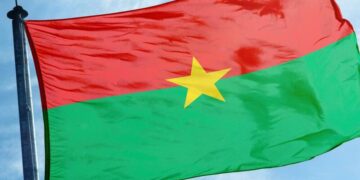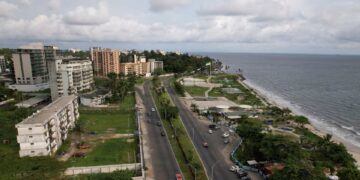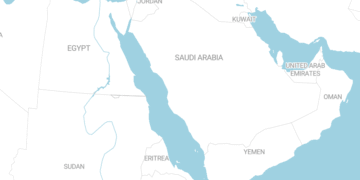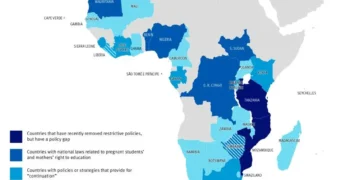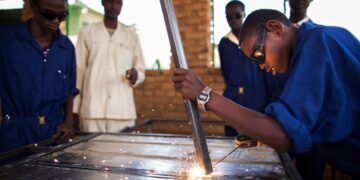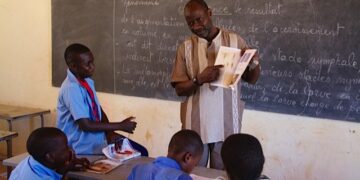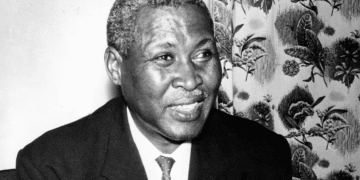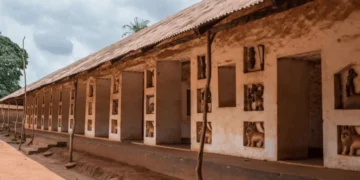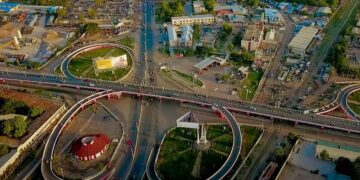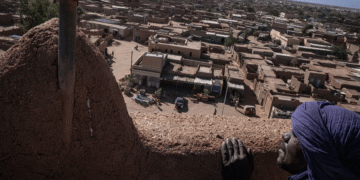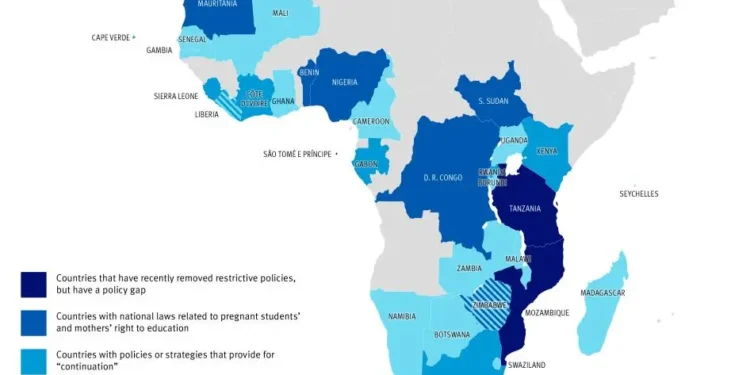Education remains an essential human right and wealth, an important motivation for financial growth, gender equality, and social progress. However, across sub-Saharan Africa, young mothers who are legally married face excessive obstacles to their educational perseverance. All legal restrictions, monetary difficulties, social stigma, and health challenge situations create an environment in which many adolescent mothers are forced to abandon their academic aspirations.
The consequences of this exclusion are severe; when young mothers are denied education, it limits their employment opportunities and can reinforce a vicious cycle of poverty that can last for generations. Moreover, their children are more likely to be less talented and perform worse in school, and this may be referred to as perpetuating inequality. Despite these challenges, significant change is evident. Governments, non-governmental organizations (NGOs), and network efforts are working to remove these barriers and provide young mothers a second chance at an education. When these complexities are understandable through supporting and effective solutions, we can create a future where motherhood does not mean the end of a girl’s education but rather a stepping stone toward empowerment and success.
Barriers Preventing Young Mothers from Accessing Education
- Discriminatory Laws and School Policies: In many African countries, pregnancy is always considered an opportunity to exclude girls from formal education. As it was recorded in 2021, Tanzania applied a short policy to expel students who were in school before their legal pregnancy, losing the opportunity to continue with thousands of young people. Even in some countries, without official rules, mothers face the punishment of the school administrator, teachers, and membership in the community. Some school policies also create unrealistic conditions for re-entry. For example, in some areas, youths need to try to oversee care compliance, such as having adequate childcare arrangements before being allowed back to school. Surely, this prerequisite strangely affects young mothers from low-income environments who cannot afford daycare. It is encouraging that some governments began to change such a policy. In Sierra Leone, the “Radical Inclusion” rule, represented in 2021, guarantees an increase in students and new comrades. In Zambia, government reforms now allow girls to return to school after childbirth, ensuring that they will not be constantly disadvantaged.
- Health Challenges and Lack of Support: No doubt, early pregnancy represents a significant health risk and can complicate continuing education. According to the World Health Organization (WHO), complications during pregnancy and childbirth are the leading cause of death among adolescent girls in sub-Saharan Africa. Young mothers often face health conditions such as anemia, hypertension, and birth-related injuries such as obstetric fistula. After childbirth, many adolescent mothers struggle with postpartum depression, exhaustion, and malnutrition, all of which can negatively impact their ability to focus on studying in school. Since many schools do not possess the medical facilities they need to support them. In response to this issue, some countries have integrated health services into schools. The school health and nutrition program in Uganda has introduced initiatives in which students can receive maternal medical care and continuing education. In addition, NGOs such as Marie Stopes International offer reproductive protection and maternal care programs, helping young mothers manage their health and occupy their education.
Economic Barriers and Financial Hardship
The cost of education is one of the most important issues for young mothers. Many families in African countries in Sub-Saharan Africa may struggle to afford school boards, uniforms, books, and transportation fees. In the event of financial difficulties, due to the fact that families often prioritize boys’ education over that of young mothers, which suggests that they have limited career prospects. The economic burden goes beyond school expenses. Many young mothers must provide for their children, so society and family may force them to choose between work and study. Without financial independence and family support, many feel that they have no choice but to abandon their education altogether.
Moreover, the financial tension that young mothers are confronted with is multiple, especially in the Sub-Saharan African countries. In many communities, the expenses associated with education, such as training, uniforms, books, and transport, are scandalous, especially for poor families. For young mothers, these costs are often exacerbated by additional responsibility for the child’s education. Hence, education becomes a luxury that one can no longer afford. This financial problem can also affect the ability of young mothers to attain and provide the necessary materials for success in academic order, such as a stable internet connection for books and research.
To further complicate the situation, young mothers can be forced to prioritize their immediate survival over education. In the fields where social security networks are limited, mothers are often the main administrators and should work on the support of their children. In some cases, the work they provide may be low, irregular, or informal, and it may be difficult to harmonize paid work with educational requirements. . This forces many to drop out of school, perpetuating a cycle of poverty that can last for generations. Furthermore, many families and communities believe that investment in education for girls, especially girls who are already mothers, offers only a limited profit. This perception is an important obstacle to the constant training of new mothers. The resulting resources and the financial resources are often sent elsewhere, such as training for men and other families. However, mothers of nine can restrict access to bags, forms of support for voluntary funds, or other funds that can encourage charging. It addresses these organizational issues, such as CAMFED (Campaign for Female Education), which are working tirelessly to provide targeted financial assistance to young mothers. Curved access includes scholarships, school uniforms, costs, and review transport. This directly reduces financial pressure. In addition, some programs offer allocations or income opportunities to help the new mothers support each other while they attend education. These initiatives have proven to be effective in increasing enrollment and retention rates among young mothers in school.
Social Stigma and Community Discrimination
Cultural norms in many African societies have set a strong stigma for adolescent pregnancy and brought embarrassment. The new mothers are often considered irresponsible or unworthy of continuous education. Many of them were faced with the discrimination of their evening, their members, and the members of the community, creating an environment in which they devoted themselves to a discouraged school.
Even when politics allows you to return a new one to school, a social desire can always pose an important problem. In some cases, teachers refuse to provide the same level of support to new mothers and classmates who are present in threats or isolation.
To counteract this stigma, organizations like the Forum for African Women Educationalists (FAWE) are running awareness campaigns to promote inclusive education. It is a program for mentoring in Ghana and Kenya in order to change the attitude and create a school environment where new mothers must continue their education.
Initiatives Addressing the Education Gap
- Inclusive Education Policies: Governments throughout Africa are starting to apprehend the significance of inclusive guidelines that could permit younger moms to go back to school. Botswana, Namibia, and Mozambique have brought guidelines that explicitly limit discrimination in opposition to pregnant college students and younger mothers. Some colleges also are imposing on-campus childcare centers, making sure that younger moms are consciousness of their studies whilst understanding their children are cared for. These initiatives reduce dropout rates and it will also create a more supportive educational environment.
- Flexible Learning Models : Recognizing that traditional school schedules may not always be suitable for young mothers, some countries are adopting more flexible learning options, including:
- Community-based learning centers, particularly in rural areas, which provide more accessible and informal education settings.
- Part-time and evening classes that allow young mothers to balance their parental responsibilities with education.
- Digital and mobile learning platforms, such as UNICEF’s mobile classrooms, which enable young mothers to study remotely at their convenience.
- Financial and Material Support: Providing financial support is important for young mothers to stay at school. Some of the most effective initiatives include:
- (a) CAMFED grants covering tuition, uniforms, and exam costs.
- (b) “Education Plus” Initiative, a collaborative attempts by Joint United Nations Programme on HIV/AIDS (UNAIDS), United Nations Educational, Scientific and Cultural Organization (UNESCO), United Nations Children’s Fund (UNICEF), and UN. It advocates for free secondary education and the expansion of the economic rights and opportunities of young teenagers, especially young mothers.
- Community Advocacy and Awareness Campaigns: Changing social attitudes is essential to ensuring young mothers are welcome in school. Across Africa, organizations use radio programs, social media campaigns, and basic initiatives to emphasize the importance of reducing stigma and educating young mothers. For example, in Zambia, radio programs were used to the success of young mothers who returned to school, inspiring others to do the same. Moreso, the mentorship programs in Kenya and Malawi connect young mothers with successful women who provide advice and encouragement.
Support for Young Mothers in Education
One of the most influential strategies in addressing the educational gap among young mothers in sub-Saharan Africa is direct support from mentors, educators and community leaders. According to Adebayo (2023), mentoring programs (FAWE), led by organizations such as the Forum for Women Educators in Africa (FAWE), connect young mothers with women who have a balanced balance between education and parenting.
These mentors provide academic leadership and emotional support, helping young mothers to restore confidence and motivation for continuing training. Similarly, Ochieng and Kamau (2022) emphasize that initiatives based on a community, such as peer support groups and school reintegration programs, significantly improved the level of retention of schools among teenage mothers in Kenya. Their study emphasizes that advancements by teachers and administrators create a more welcoming educational environment, reduce stigma, and contribute to active participation. Besides, Mensa (2021) points out that teachers trained in gender education systems play a critical role in ensuring that young mothers do not feel isolated under school conditions. Schools that implement comprehensive policies, including flexible attendance times and child-friendly care on campus, are more likely to help young mothers succeed in their studies.
Lastly, the gap in the education of young African mothers in Sub-Sahara Africa is not insurmountable. Governments and organizations can create educational systems that approve young mothers by eliminating discriminatory policies, expanding financial aid, providing medical assistance, and changing public awareness. When a young mother is educated, the benefits go beyond herself. Children are healthier and are better trained, families are more financially stable, and communities are beneficial for their skills and contributions. The message is clear, childbirth is not an obstacle to education. Instead, education must be the foundation of a better future for young mothers, their children, and their society.
ــــــــــــ
References
Adebayo, T. (2023). Empowering young mothers through mentorship:The role of support in education. African Journal of Educational Development, 15 (3), 45-62.
Camfed. (2023). Empowering young women through education:CAMFED’s approach and impact. Campaign for Female Education. https://www.camfed.org/impact.
Fawe. (2021). Mentoring young mothers in education. FAWE Africa. https://www.fawe.org/mentorship-programs.
Marie Stopes International. (2023). Reproductive health programs for young mothers in sub-Saharan Africa. https://www.mariestopes.org/africa.
Mensah, P. (2021). Gender-sensitive education:Supporting young mothers in sub-Saharan Africa. Journal of Women’s Education and Development, 10 (4), 112-127.
Ochieng, D., & Kamau, R. (2022). Community-based education initiatives for adolescent mothers in Kenya: A case study. East African Journal of Educational Research, 8 (2), 78-95.
Sierra Leone Government. (2021). Radical Inclusion policy:Ensuring equal access to education for pregnant students and young mothers. Government of Sierra Leone. https://www.education.gov.sl/radical-inclusion.
Unesco. (2022). Education for all:The role of education in empowering young women in sub-Saharan Africa. UNESCO. https://www.unesco.org/education.
Unepa. (2023). Adolescent pregnancy and maternal health challenges in sub-Saharan Africa. UNFPA. https://www.unfpa.org/adolescent-pregnancy.
Who. (2022). Adolescent pregnancy and maternal health in sub-Saharan Africa. WHO. https://www.who.int/adolescent-pregnancy.


